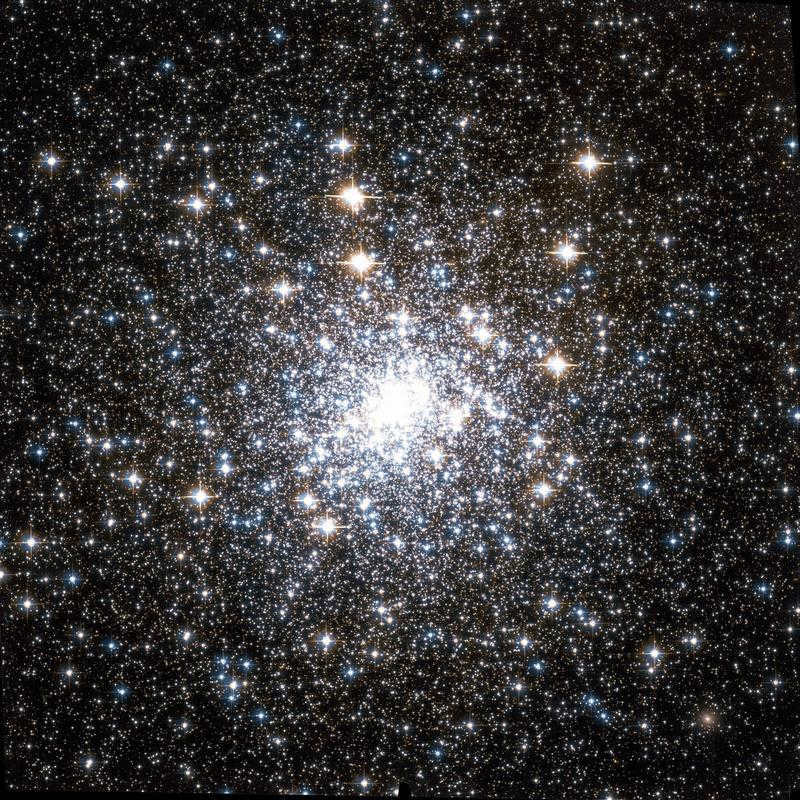- I am a photographerA plugin that allows users to publish their photos in their diary. It has minimum system requirements: Internet Explorer 6, Firefox 1.5, Opera 9.5, Safari 3.1.1 with JavaScript enabled. It might work for you
- Always within reachThere are no similar products ^_^ It enables you to insert a panel with any HTML code into your profile. You can place banners, counters, and other elements there.
- Affordable airline ticketsGreat prices, easy search, no commission, available 24 hours. Book now – pay later!
- PostcardsA renewed catalog of postcards for all occasions
- Yandex.blogs rating buttonsAdds Yandex rating buttons to your profile. More monthly rating change graphs will be added soon
–Find information in the diary
–Get updates by email
–View the statistics
It’s time to focus on the top of the Zodiac Circle – Capricorn.
Capricorn is a constellation located in the southern hemisphere, positioned between Aquarius and Sagittarius.
This constellation can be seen in the southern and central regions of Russia. The best time for observing Capricorn is during the months of July and August.
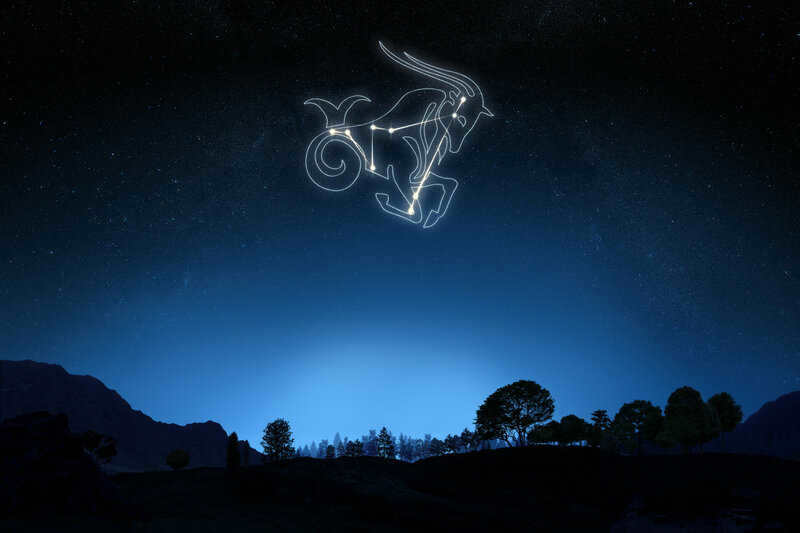
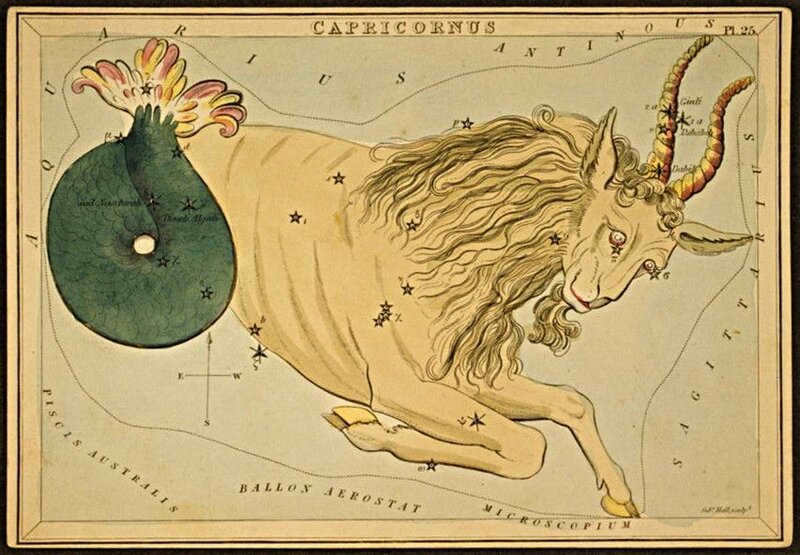
The constellation Capricorn appears as a smiling figure when you connect all its endpoints in the night sky.
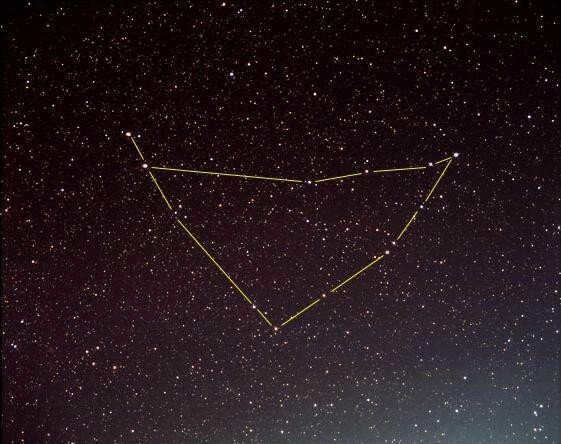
Capricorn’s most prominent celestial body is the primary star, δ Capricorn, which shines with a visual magnitude of 2.87. Capricorn is also home to the impressive globular cluster M30, which boasts an incredibly dense nucleus. One particularly fascinating star in Capricorn is Alpha Capricorn, a binary star system composed of two unrelated stars known as Prima Giedi and Secunda Giedi, both of which exist within their own physical binary systems.
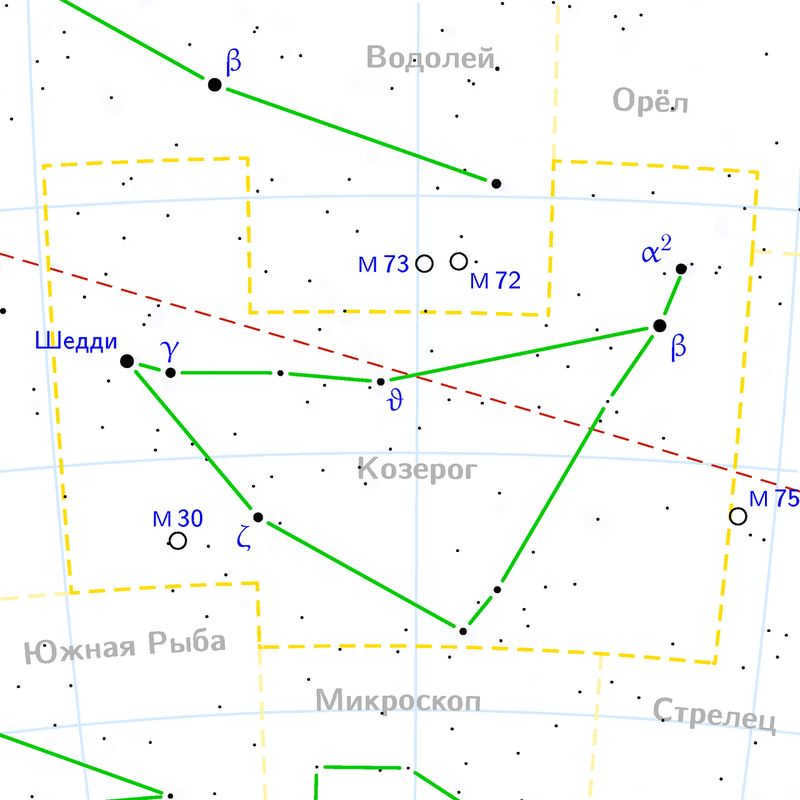
The discovery of the planet Neptune in 1846 was made by Johann Galle and Heinrich d’Arré in this particular constellation.

The starry sky of Aspen, Colorado, USA showcases the constellation Capricorn (located at the center of the image).
Traditionally, the Sun occupies the constellation from January 19 to February 15.
About 2,000 years ago, during the formation of constellation names in ancient Greece, Capricorn aligned with the winter solstice point. This association led to the naming of the southern tropic as the Tropic of Capricorn. Capricorn is also featured in Claudius Ptolemy’s comprehensive catalog of the starry sky, known as “Almages”.
In the first Russian star chart commissioned by Peter the Great in 1699, created by I. F. Kopievsky, this constellation is referred to as Goat or Capricorn.
According to the legend, Zeus came into existence during the winter solstice on the island of Crete, inside a cave located on Mount Ida. In a cruel act, his father Cronus murdered all of his offspring. However, Zeus’ mother Rhea, who was wise and cunning, managed to deceive Cronus by replacing the baby with a stone wrapped in a blanket, which he swallowed without suspecting anything.
Zeus was then nurtured by a goat named Almathea, also known as Amalthea, who provided him with her milk. In gratefulness for her generosity, the mighty god Zeus immortalized her by transforming her into the constellation Capricorn, which can be seen among the stars in the night sky.

The young Jupiter is nourished by the milk of the goat Amalphea
In accordance with an alternate myth, Capricorn is associated with Pan, the deity of woodlands, fields, and shepherds. Born to Driope and Hermes, he had goat legs and horns, and was completely covered in wool. He was revered as the guardian of shepherds.

Zeus and Capricorn were raised side by side on the beautiful island of Crete. Capricorn played a vital role in supporting Zeus during his epic battle against Cronus, all in pursuit of ultimate power.
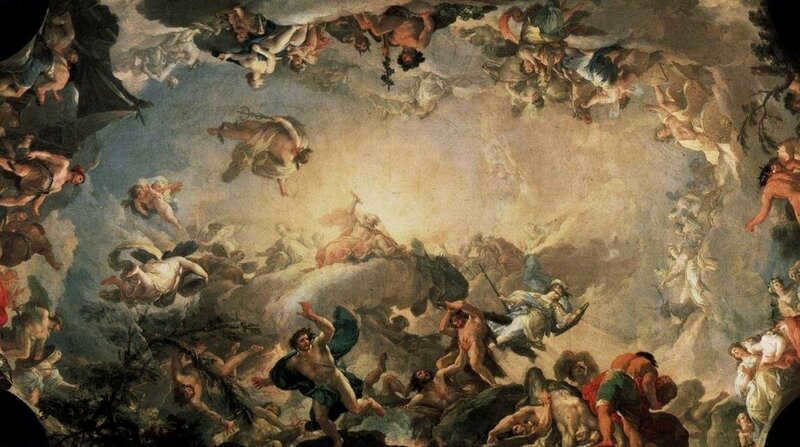
Francisco Bayeu and Subias, Titans, Battling the Giants

As a result of his escape from the wrath of Typhon, the god Pan found himself submerged in the Nile and underwent a remarkable transformation. His lower body took on the characteristics of a fish, leading to his eventual elevation to the heavens as a constellation.
The goat has long been revered as a sacred creature by various cultures around the world, with rituals and worship services dedicated to honoring its significance. The constellation Capricorn, in particular, is associated with a custom that symbolizes the concept of a “scapegoat”.
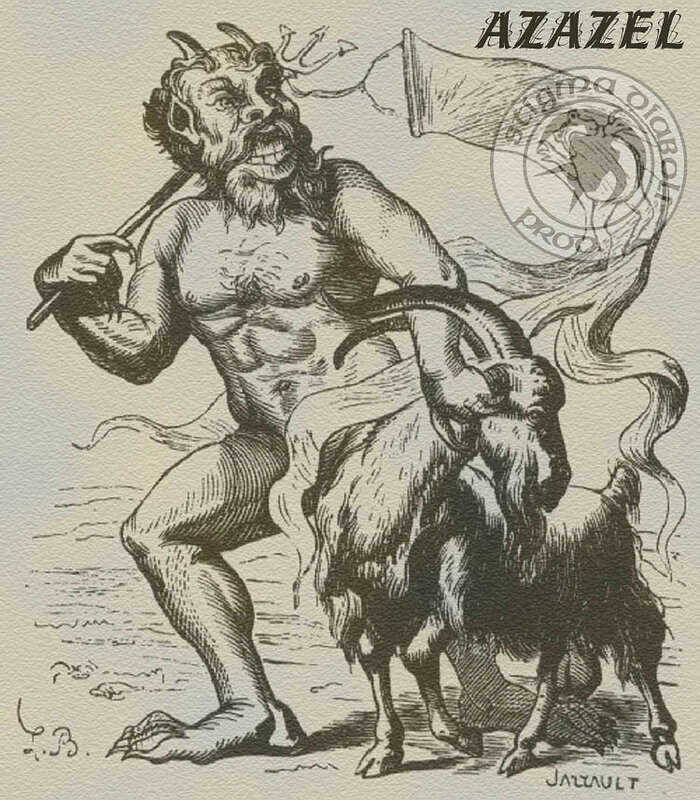
Azazel was believed to be a demon resembling a goat that resided in the desert. On a specific day, two goats were chosen, with one being designated as a sacrifice for the deity and the other being released into the desert as a representation of the underworld and offering to Azazel. After the sacrificial ritual, the high priest would lay his hands on the remaining goat, symbolically transferring all the sins of his people onto it. The animal would then be set free in the wilderness, symbolizing the act of “letting go of the goat”.
In certain regions of the Eastern world, Capricorn was known as the “Southern Gate of the Sun” due to its position as the constellation where the Sun reaches its lowest point on the ecliptic.
The zodiac sign Capricorn governs the period from December 22 to January 20, inclusive.
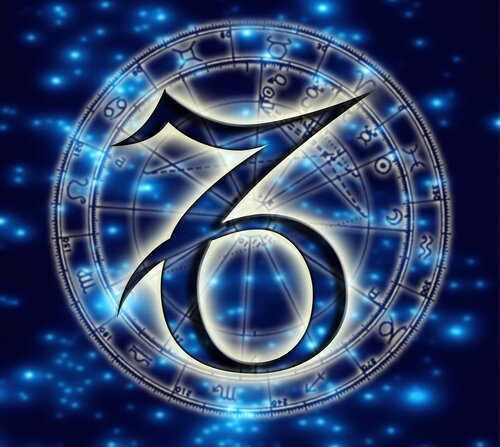
The planet associated with Capricorn is the serious Saturn
Fortunate Colors: Brown, Steel, Gray, Black
Flowers associated with Capricorn: Carnation
Stone associated with Capricorn: Garnet
Capricorn is an Earth sign
The prominent element of Capricorn – Earth represents the physical realm, prosperity, dependability, and pragmatism.

There are two distinct types of the Capricorn zodiac sign:
One type embodies the mountainous Capricorn, always striving upwards without ever pausing or restraining its impulses until it reaches the summit.
The other type is the domesticated Capricorn, lacking a strong desire for adventure, having modest ambitions, and often being satisfied with what it already has. This type will not take action unless it is pushed.
However, regardless of the type, Capricorn is known for being the most resilient and enduring both mentally and physically among all the zodiac signs.
One can acquire the skill to recognize this signal, but it requires some preliminary training. Take note of the silent spider lurking in the corner. It may appear that he has no opportunity to capture those airborne flies. However, they become ensnared in his cunningly positioned webs and he emerges victorious.

Those born under the sign of Capricorn have a knack for navigating the social hierarchy, steadily making their way up from one level to the next. They may not initially stand out or draw attention to themselves, but they always manage to stay one step ahead. Despite facing seemingly insurmountable odds, Capricorns somehow come out on top, leaving their competitors in awe and wondering how they did it.
At first glance, Capricorns may appear gentle, timid, and a bit stubborn. They give off an air of harmlessness that may make you believe they are the perfect person to confide in and share your secrets with. However, it’s important to know that Capricorns have a knack for using your weaknesses and secrets to their advantage, ultimately strengthening themselves in the process.

Capricorn is the most secretive astrological sign.
It is incredibly difficult to fathom what goes on in the minds of individuals born under this constellation.
They seldom confide in others about their feelings and experiences, and in public, they often appear distant and aloof.
The Achilles’ heel of Capricorn is their excessive self-esteem, which often leads to suffering for both Capricorns themselves and their loved ones. Instead of focusing on the cause of conflicts, Capricorns tend to analyze the situation or problem at hand, as their own behavior is often at the root of the issue.
Capricorns are unwaveringly loyal to their principles and will fiercely defend them. They have high expectations for themselves and those around them.
Capricorn, the constellation that has been associated with famous individuals such as Moliere, Isaac Newton, Federico Fellini, Mao Zedong, Isaac Asimov, Elvis Aaron Presley, Joan of Arc, Buddha, and Jesus Christ.
The constellation known as Capricornus can be found in the southern sky. It earned its name “Capricornus” from the Latin word for “goat.”
Capricornus is part of the zodiac group, which consists of the 12 signs of the zodiac. It is considered one of the less prominent constellations. Along with the rest of the zodiac group, it was documented by the Greek astronomer Ptolemy in the second century. The history of Capricornus is connected to two myths: the god Pan and the goat Almathea, who nursed the young Zeus. The constellation is home to several notable stars, as well as the Messier 30 globular cluster.
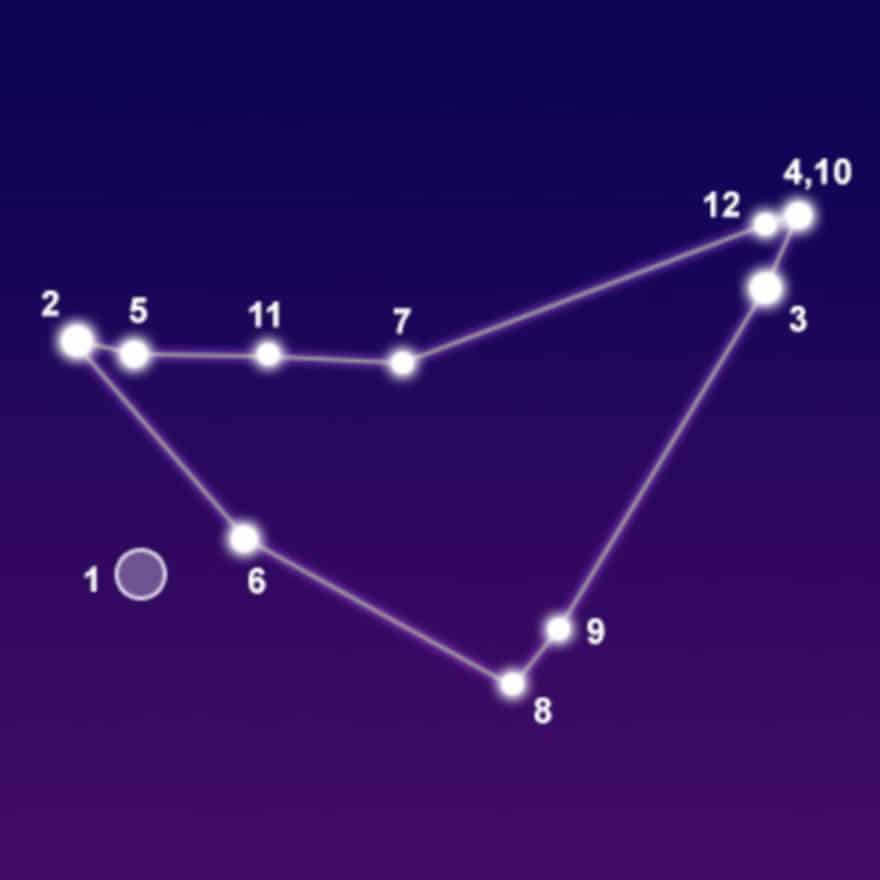
Facts, Location, and Map
The constellation Capricorn is ranked 40th in magnitude and covers an area of 414 square degrees. It is situated in the fourth quadrant of the southern hemisphere (SQ4) and can be observed at latitudes ranging from +60° to -90°. Capricorn shares its borders with Aquarius, Microscope, Sagittarius, South Pisces, Pisces, and Eagle.
Within the constellation Capricorn, you can find three stars that have planets orbiting them, along with Messier 30 (M30, NGC 7099). The brightest star in Capricorn is Delta. Additionally, there are five meteor streams associated with Capricorn, namely Alpha Capricornidae, Chi Capricornidae, Sigma Capricornidae, Tau Capricornidae, and Capricornidae-Sagitarii. Capricorn is part of the zodiacal family, which includes Aries, Taurus, Gemini, Cancer, Leo, Virgo, Libra, Scorpio, Sagittarius, Aquarius, and Pisces. Take a look at the star chart to see the visual representation of the constellation Capricorn.
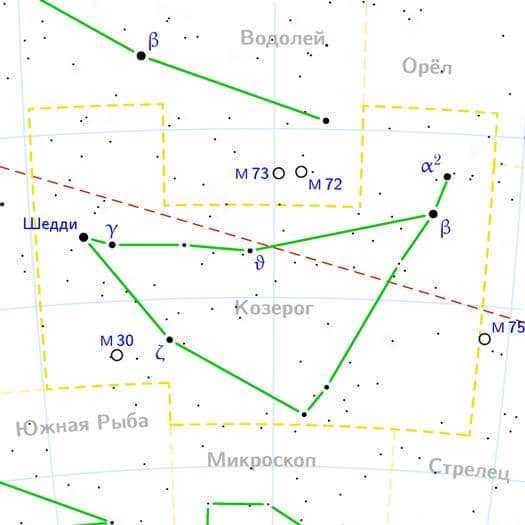
Legend
Despite being the second weakest constellation, Capricorn has a rich history dating back to the 21st century B.C. It originated with the ancient Sumerians and Babylonians, who referred to it as the “goat-fish” (SUHUR-MASH-HA). During the early Bronze Age, Capricorn represented the winter solstice. Today, in modern astrology, it is still associated with the first day of winter.
In Greek mythology, Pan was often depicted as a forest deity with goat horns and hooves. He was also the father of Krotus, who was associated with the Sagittarius constellation. Pan played a significant role in protecting and aiding the gods of Olympus, for which he was praised by Zeus. During the war against the Titans, Pan used his shell to frighten and intimidate them. He also warned the gods about the approaching monster Typhon and suggested that they transform into animals during dangerous situations.
There is a myth explaining Pan’s peculiar appearance. It is said that Pan attempted to transform himself into a fish and hide in the Nile to escape from a monster. However, the transformation was only partially successful, and he was ultimately captured by the monster.
Prominent celestial bodies
Discover the brilliant celestial bodies found within the zodiacal constellation of Capricornus. This section provides detailed explanations, captivating photographs, and comprehensive characterizations of these stars.
Deneb Algedi (also known as Delta Capricorn) is a fascinating four-star system located 39 light-years away. The primary star, Delta A, is a luminous white giant that belongs to spectral class A. With a brightness 8.5 times that of the Sun, it stands out as the brightest star in Capricornus. This star system is characterized by its spectroscopic eclipsing double nature. The giant and its companion revolve around a shared center every 1.023 days, resulting in periodic decreases in luminosity by 0.2 magnitudes during eclipses.
Delta A is classified as a Delta Shield variable due to its varying brightness caused by radial and non-radial surface pulsations. Additionally, two other stars are thought to be in orbit around this system. Delta Capricorn C, a 16th magnitude star, is situated at a distance of 1 arc minute, while Delta Capricorn D, a 13th magnitude star, can be found approximately 2 arc minutes away from the central star of the system.
In general, it is the most brilliant star in the constellation with a visible magnitude of 2.85. Traditional names: Deneb Algedi is derived from the Arabic ðanab al-jady, which means “goat’s tail”. Situated close to the ecliptic, it can be obscured by the Moon and planets.
Dabih (Beta Capricorn) – a system of stars located 328 light years away, positioned near the ecliptic. Beta-1 Capricorn (brighter, with a visible magnitude of 3.05) and Beta-2 Capricorn (visible magnitude of 6.09) are depicted. They are separated by 3.5 angular minutes (0.34 light-years) and complete an orbit every 700,000 years.
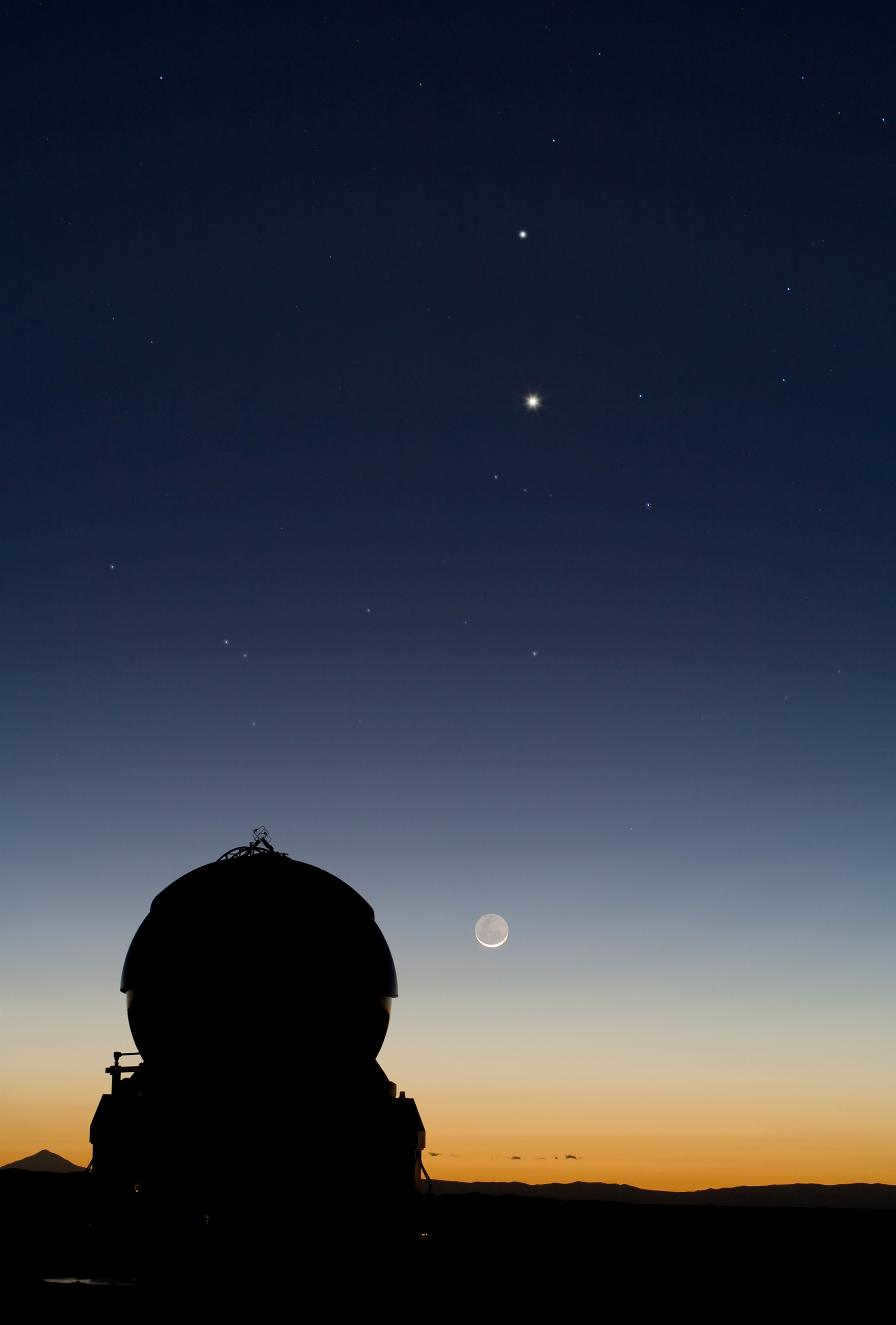

Mercury and Venus can be observed together with Gamma and Delta Capricorn (on the right).
Both constellations consist of multiple stars. Beta-1 contains at least 3 components. The brightest star is an orange giant of K-type, with a visible magnitude of 3.08. The second star (the most powerful one) is a blue-white main-sequence dwarf of B-type, with a magnitude of 7.20. They are separated by 0.05 arc seconds and complete one revolution in 3.77 years. The other star has an unseen companion that orbits around it every 8.7 days.
Beta-2 Capricorn is a binary star system consisting of an A0-class giant with a magnitude of 6.1 (which is 40 times brighter than the Sun) and a mercury-manganese star located 3 angular seconds away.
Dabih, the second brightest star in Capricorn, derives its traditional name from the Arabic word al-dhābiḥ, which means “butcher”.
Algidi, also known as Alpha Capricorn, is an optical double star. Its name is derived from the Arabic word al-jady, which means “goat”. Algidi is composed of two star systems, Alpha-1 Capricorn and Alpha-2 Capricorn, which are separated by 0.11 degrees in the sky.
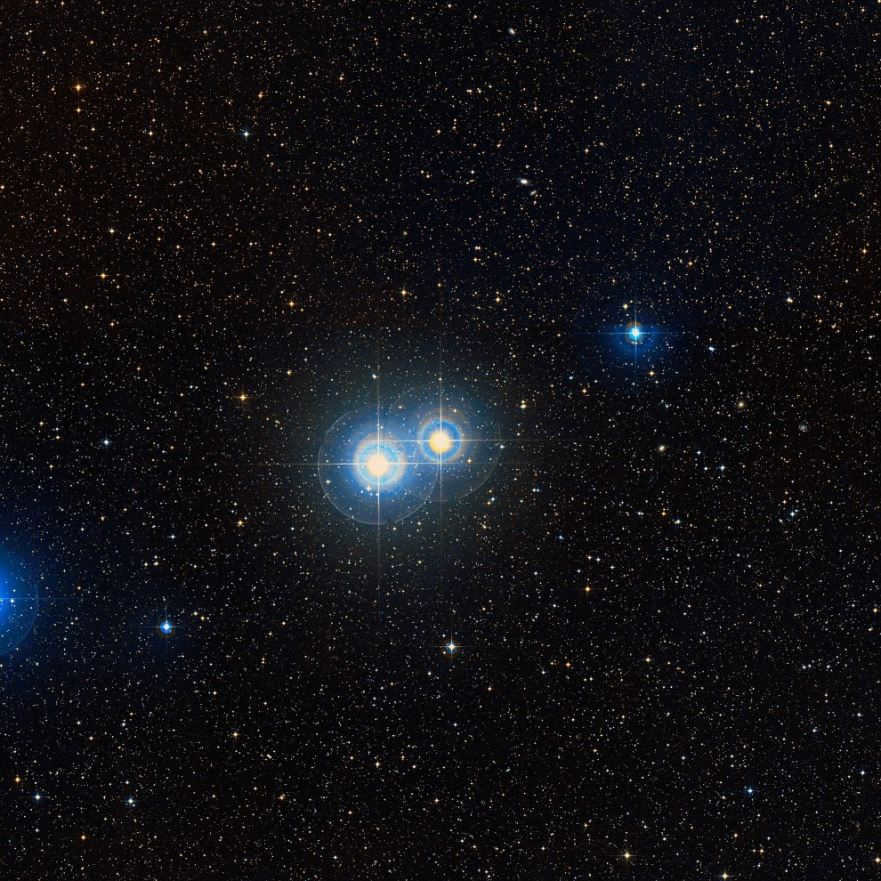
Alpha-1 Capricorn is a binary star system situated 690 light-years away. It consists of a yellow supergiant of the G-type with a magnitude of 4.30, and a companion star with a magnitude of 8, located at a distance of 0.65 arc seconds.
Alpha 2 of Capricorn is another yellow giant star of the G-type, found 109 light-years away. It has a magnitude of 3.58 and is the brighter of the two components.
Gamma Capricorn is a giant star of the A-type, appearing white-blue in color. It is located 139 light-years away and its name can be translated from Arabic as “bearer of good news.” The visible magnitude of this star is 3.69. It is positioned close to the ecliptic and its brightness varies by 0.03 magnitude. This star is classified as an Alpha-2 Hound Dog type variable, indicating the presence of strong magnetic fields.
Zeta Capricorn is a binary star composed of a yellow supergiant of the G spectral type and a white dwarf. It has an apparent magnitude of 3.77 and is located 398 light-years away. The brighter component of this star system is a barium star that exhibits an excess of praseodymium.
Dorsum, also known as Theta Capricorn, is a white dwarf of the A spectral type. It is situated 158 light-years away and has an apparent visual magnitude of 4.08. The name Dorsum translates from Latin as “back (of a goat)”.
Omega Scorpius is a red giant of the M spectral type found 630 light-years from Earth. Its name is derived from the Arabic term for “belly of the goat”. With an apparent magnitude of 4.12, Omega Scorpius is a variable star that undergoes regular changes in brightness and absolute magnitude.
Psi Capricorn is a giant star with a yellow-white color and a spectral class of F5 V. It is located 47.9 light-years away and has an apparent magnitude of 4.15.
Celestial entities
Messier 30 (NGC 7099) represents a globular cluster located at a distance of 28,000 light-years. It spans an area of about 90 light-years in diameter.
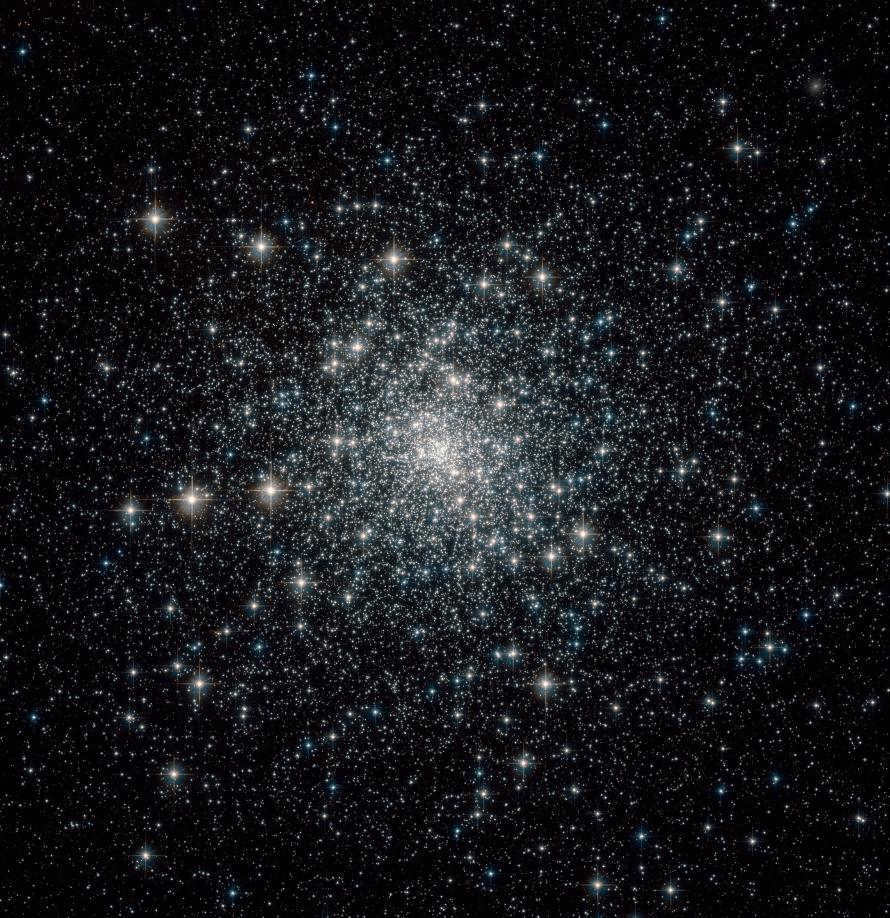
The cluster is coming towards us at a velocity of 181.9 km/s. It was one of the initial celestial objects discovered by Charles Messier in 1764. Its spectral type is F3. It has a relatively high density and falls under concentration class V. The most luminous stars are red giants with a magnitude of 12.
Similar to Messier 15, Messier 7, and numerous other globular clusters in the Milky Way, M30 has undergone a core collapse. It is now only 0.12 arc minutes in size, with half of the cluster’s mass contained within a spherical radius spanning 17.4 light-years across. M30 can even be observed with faint telescopes.
If you want to study the zodiacal constellation Capricorn in more detail, you have the opportunity to do so using not only our photographs but also 3D models and online telescopes. A star map will be sufficient for your own exploration.
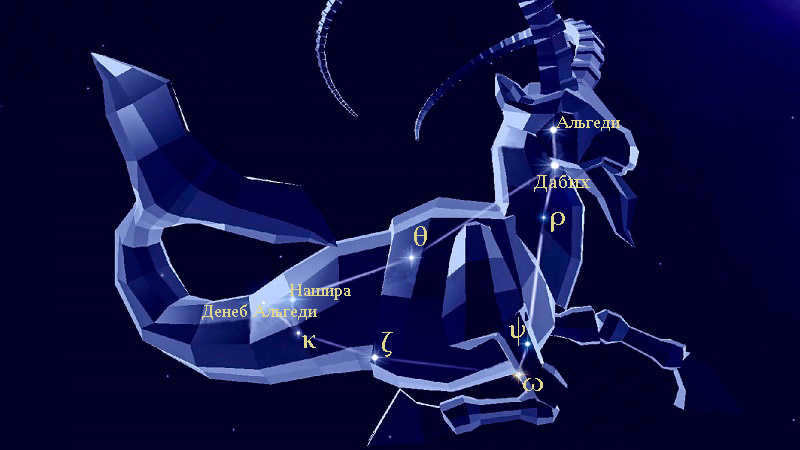
Capricorn is part of the 12 zodiacal constellations and is known for being the smallest. Despite its stars being dim, it can still be observed in the sky without the need for a telescope.
Appearance and Location
To spot Capricorn in the sky, you’ll need to put in some effort. In Latin, it is referred to as “Capricornus”. The paths of the Sun, Moon, and other planets cross through this constellation. The Sun passes through Capricorn from January 19 to February 15, making it nearly impossible to see during this time.
City dwellers face challenges when trying to locate the Capricorn constellation in the night sky due to the overwhelming presence of electric light. This excess illumination obstructs the view of the stars and makes it difficult to discern the constellation’s distinctive pattern. However, those who venture outside of well-populated areas and distance themselves from the bright city lights have a higher chance of spotting Capricorn without the aid of a telescope. In these less illuminated regions, the night sky becomes significantly brighter, revealing a multitude of stars that would otherwise go unnoticed.
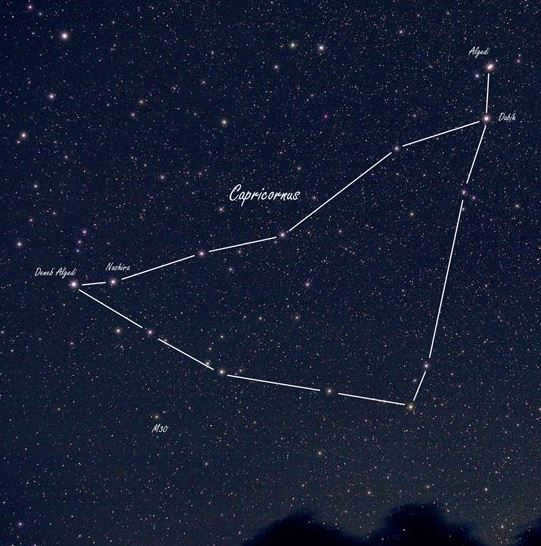

The Capricorn constellation is visible just before sunrise in late February and in the early morning in March. It appears in the southeastern part of the sky against the backdrop of the morning dawn. The optimal time to observe this constellation is during the autumn season. After the sun sets, it can be located in the southern region of the sky.
To locate the Capricorn constellation, one can use the Sagittarius constellation as a guide. Capricorn forms a small curved pattern near Sagittarius. It is most prominently visible in the winter months in the southern hemisphere and during the summer months in the northern hemisphere.
The Babylonians associated this ancient pattern with the Goatfish, while the Chinese depicted it as a turtle. In the South Pacific, it was likened to the entrance of a cave.
In Russia, the constellation Capricorn is not easily visible in the sky due to its low position. In the central region, it can be seen in the latter half of spring and early summer, and in the southern region in the mornings from mid-April. From August onwards, the constellation can be observed throughout the country. To locate it, one should search in the fourth quadrant of the southern hemisphere, within latitudes ranging from +60° to -90°.
Discovery and Myths: A Journey Through History
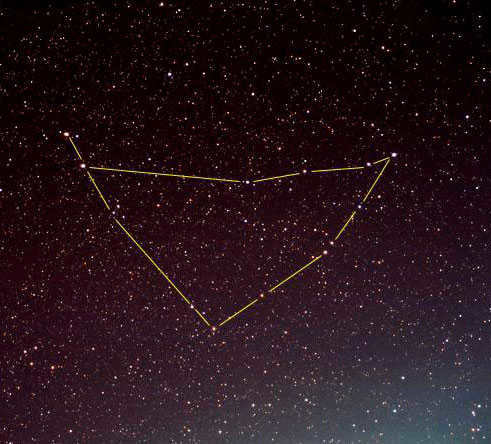
The Greek astronomer Ptolemy included Capricorn in his 2nd century Almagest catalog, adding it to the list of constellations. This constellation was known to both Ptolemy and ancient peoples, who referred to it as Goat, Fish-Goat, or simply Goat. It was during the study of Capricorn in 1846 that the planet Neptune was discovered.
While scientists have yet to reach a consensus on the origin of the stars in this constellation, there are various ancient myths and legends surrounding it.
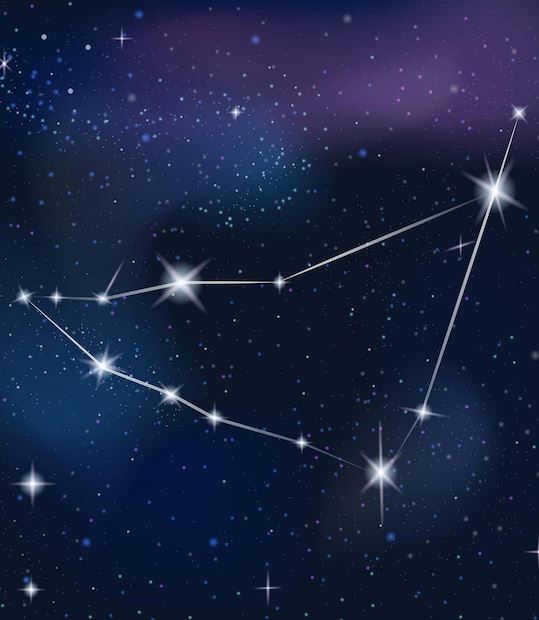
One of the most well-known mythical tales surrounding the formation of the Capricorn constellation is linked to the deity Zeus. Zeus, the offspring of Cronus, was prophesied to overthrow his father. In order to protect Zeus, his mother, the goddess Rhea, kept his parentage a secret from Cronus. She feared that Cronus would devour his newborn son, as he had done with all of his other children.
The constellation Capricorn’s stars
There are approximately 20 stars that form the pattern of the Capricorn constellation. The most prominent among them is Deneb Algedi. It is represented by the letter “δ” (delta) in Latin and is a binary star, with its components indistinguishable even when observed through a telescope. The star’s name translates to “tail of the goat”. Deneb Algedi is classified as an Algol-type star and is a variable star of the eclipsing variety. Its magnitude is 2.81 m and can decrease by 0.24 m.
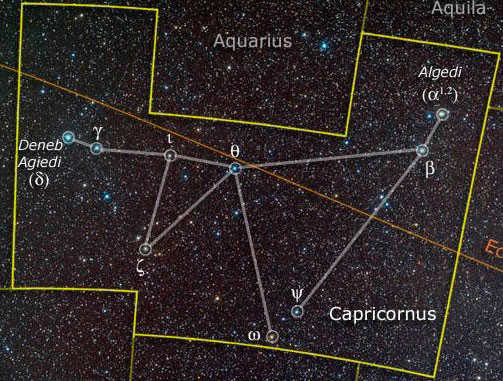
The second most luminous celestial body in the constellation of Capricornus is known as Dabih. It is denoted by the Greek letter “β” (beta) and is situated approximately 340 light-years distant from our planet. Its appellation, “Dabih,” signifies “butcher” in the English language. Dabih is a stellar system comprising of the Greater Dabih, also referred to as Beta-1 Capricorn, and the Lesser Dabih, or Beta-2 Capricorn. Notably, Beta-2 Capricorn is a binary star. Dabih is classified as a yellow giant star.
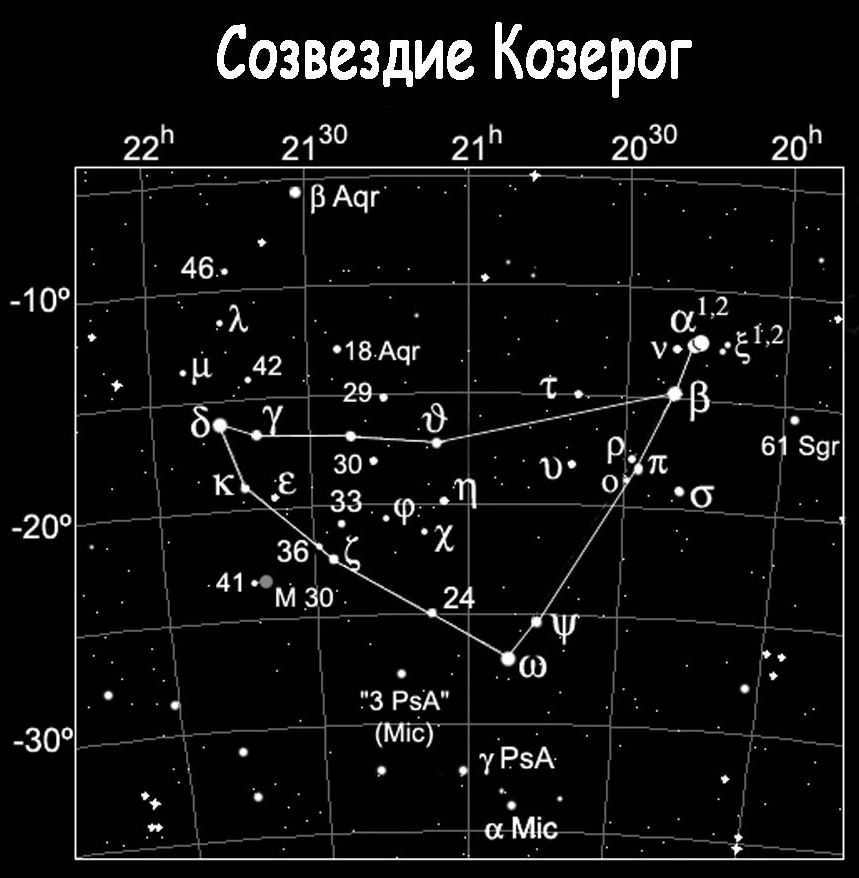
There are also other notable stars in the Capricorn constellation:
- Gamma Capricorn (Nashira);
- Zeta Capricorn;
- Theta Capricorn (Dorsum);
- Omega Capricorn;
- Psi Capricorn;
- Iota Capricorn;
- Nu Capricorn;
- Alpha Capricorn (Aljedi).
The International Astronomical Union (IAU) has approved the names of the five stars that make up the Capricorn constellation (Algedi, Alshat, Dabih, Deneb Algedi, Nashira).
In addition to the stars, Capricorn is also home to the globular cluster M30. This celestial object was discovered by Charles Messier in 1764 in the southeastern region of Capricorn.
The round nebula without any stars was characterized by the astronomer. At present, the angular size of M30 is 0.12 minutes. The nebula’s apparent magnitude is 7.2. It is observable in the night sky through a telescope. Additionally, there are five meteor streams located in the Capricorn constellation.
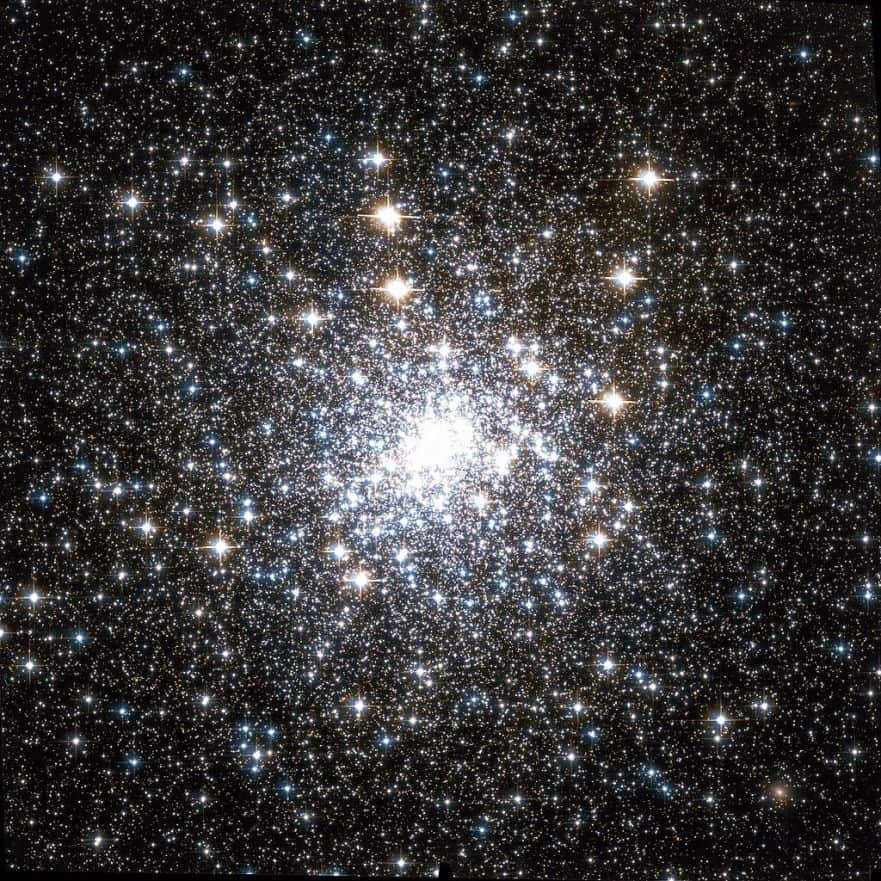
Fascinating details
- Capricorn is the smallest constellation of the zodiac. It contains several galaxies and the nebular cluster M30.
- French astronomer Charles Messier first discovered the nebula, which was later confirmed by Englishman Herschel 20 years later.
- The Capricorn constellation is not visible in the sky in northern latitudes.
Algedi is an optical double star consisting of celestial bodies. The distance between Alpha 1 and Alpha 2 is 690 light years.
Deneb Algedi is a system with four stars. It can be found 39 light years away from Earth.
The star Delta is 8.5 times more luminous than the Sun.
The constellation Capricorn experiences its highest meteorite activity from mid-July to August.
M30 is located 26,000 light-years away from Earth.
The constellation Capricorn, although not the brightest or the largest, holds numerous mysteries. Our article will provide information on how to locate the constellation in the sky, its visibility, the stars it includes, and the legends that surround it.
The constellation of Capricorn: its location and appearance
Even for skilled stargazers, finding the Capricorn constellation (also known as Capricornus or the horned goat) can be a challenge. It consists of 86 stars that are visible to the naked eye, but they are not particularly bright. Additionally, the shape of the constellation, resembling the smile of the Cheshire Cat, is not as easily memorable as the Big Dipper’s bucket silhouette, for example. Furthermore, Capricorn is the smallest constellation in terms of angular area among the Zodiac constellations. It covers only 413.9 square degrees, which is just 1 percent of the night sky. In terms of size, Capricorn ranks 40th among all known constellations and 16th in the Southern Hemisphere.
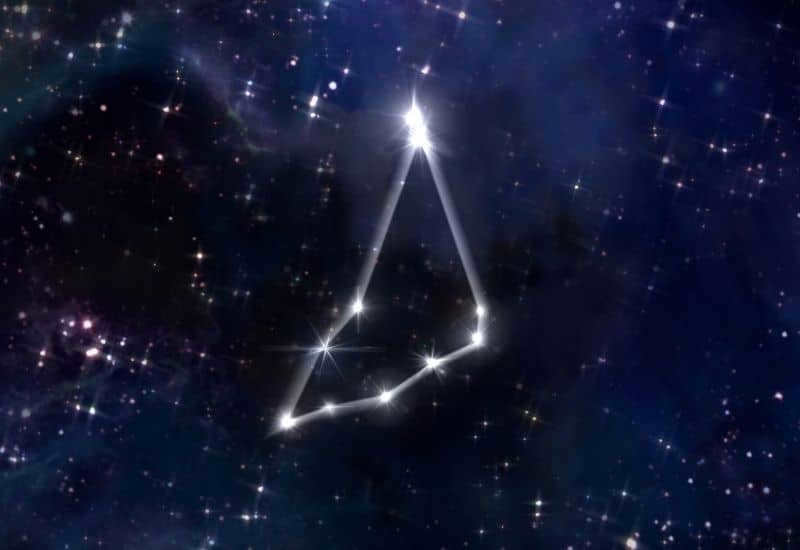
However, if you are aware of the celestial coordinates of the Capricorn constellation, you won’t have to struggle for long to locate it. Just look towards the southern direction. There, slightly above the horizon, you will be able to observe the faintly sparkling stars that create the shape of Capricorn or, as our ancestors used to refer to it, the goatfish. Just remember to unleash your creativity! Interestingly, this compact constellation contains the Sun within its boundaries for a duration of 28 days – from January 20 to February 16. This phenomenon is tied to the ecliptic line, which represents the path traversed by the Sun throughout the year, and it happens to intersect with the widest part of Capricorn’s “body”.
What is the best time to spot the constellation Capricorn in the sky?
If you are in Russia, you will have the opportunity to witness the constellation Capricorn throughout the night from July 23 to August 21. The optimal time to observe it is around midnight, when it reaches its highest point in the sky, known as culmination.
Capricorn can be observed in the evening starting from December, and after midnight from June. From January to March, this constellation cannot be found in the night sky. To locate Capricorn in the celestial hemisphere, a star map can be used. In scientific terms, Capricorn is situated in the southern hemisphere’s 4th quadrant, known as SQ4. It occupies latitudes ranging from +60 to -90. Sagittarius, South Pisces, Microscope, Eagle, and Aquarius are some of the neighboring constellations.

The constellation Capricorn can be observed in the celestial sphere and at specific coordinates, that is, by using the stars as a reference. The most prominent among the stars of visible magnitude that form the constellation is known as Sheddy or Cap. We will provide more information about the stars below.
So how can you locate the constellation Capricorn in the nocturnal sky?
To locate the constellation Capricorn in the dark night sky, you can rely on visual representations, such as images of the constellation available on the Internet. Additionally, keep in mind that the constellation is positioned very low above the horizon line in the southern part of the sky. In diagrammatic form, the constellation Capricorn appears as a triangle with irregular and indented sides.
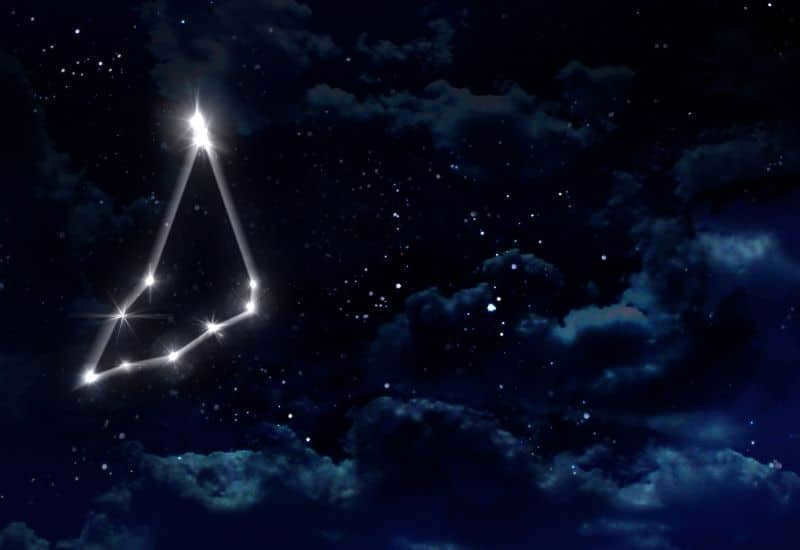
Experienced astronomers often direct their attention to the Sagittarius constellation, as it is more luminous and prominent. In close proximity to Sagittarius, along the ecliptic line, lies the constellation of Capricorn. Another method of locating this constellation is by using star navigation. To begin, one must locate the renowned Summer-Spring Triangle, which consists of three brilliant stars: Altair from the Eagle constellation, Vega from Lyra, and Deneb from Cygnus. The Eagle constellation can be found in the northwest in relation to Capricorn. Once again, the ecliptic line will be of assistance in pinpointing its position.
Brightest stars and meteor streams of the constellation
The constellation Capricorn was extensively studied by ancient astronomers, particularly those from the East, which is why the stars in the constellation have Arabic names.
If you were to create a visual representation of the Capricorn constellation, it would be essential to highlight the brightest stars along the outline. Here are a few notable examples.
Deneb Algedi: The Alpha Star of Capricorn
Deneb Algedi, also known as the Tail of the Goat due to its Arabic translation, is not your ordinary star. In fact, it is a double star system that consists of a white giant. This may explain why Deneb Algedi shines more brightly than any other star within the Capricorn constellation. Located 50 light-years away from the Sun, Delta Capricorn holds the title of an eclipse variable, as its luminosity fluctuates throughout the day, ranging from 2.88 to 2.95 m (magnitudo, derived from Latin, meaning size).
The term Dabih translates to Butcher. Once again, this is not a typical star, but rather a complex multiple star system, although it is not as bright as Deneb. When observing Dabih through a telescope, you will notice two stars known as the Big Butcher and the Small Butcher. However, this is an optical illusion! The Big Butcher consists of an orange giant star and a blue-white dwarf. The Small Butcher consists of a pair of stars, with one being a second-class giant.
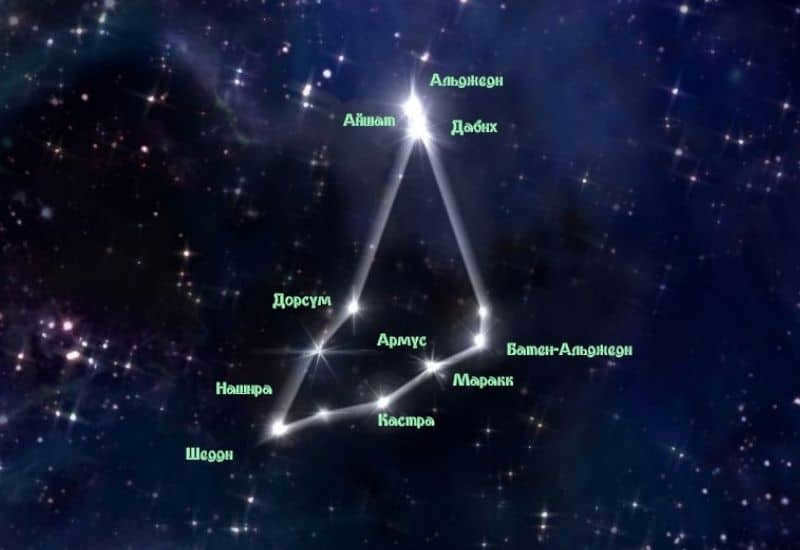
Algedi or Alpha Capricornus
The constellation Capricornus is composed of two stars, known as Algedi or Alpha Capricornus. These stars have a magnitude of fourth and are not physically connected to each other. However, from the perspective of an observer on Earth, they appear to merge into a single entity.
Nashira, also known as the Capricorn Gamma.
Lucky is a massive blue-white star, ranking as the fifth most luminous in the constellation. At last, we are witnessing the brilliance of a singular celestial body.
The Capricorn constellation is traversed by various meteor streams. These streams, numbering five in total, bear a shared family designation derived from the term Capricornus – Capriconidae. They are known as Capriconidae-Sagittariidae, Alpha Capriconidae, Tau Capriconidae, Hi Capriconidae, and Sigma Capriconidae.
What celestial objects can we observe in the Capricorn constellation?
Due to its relatively small size, there are not many fascinating cosmic events within this constellation, but there is still plenty to discuss.
One such object is Messier 30 or M30, as well as NGC 7099. This particular object is a globular star cluster that can be found within the boundaries of the Capricorn constellation. It emits light from deep space, which takes approximately 28,000 light-years to reach Earth. The size of this cluster is around 90 light-years, and it falls under the spectral type F3. The cluster was named in honor of the scientist Charles Messier, who first discovered it in 1764.
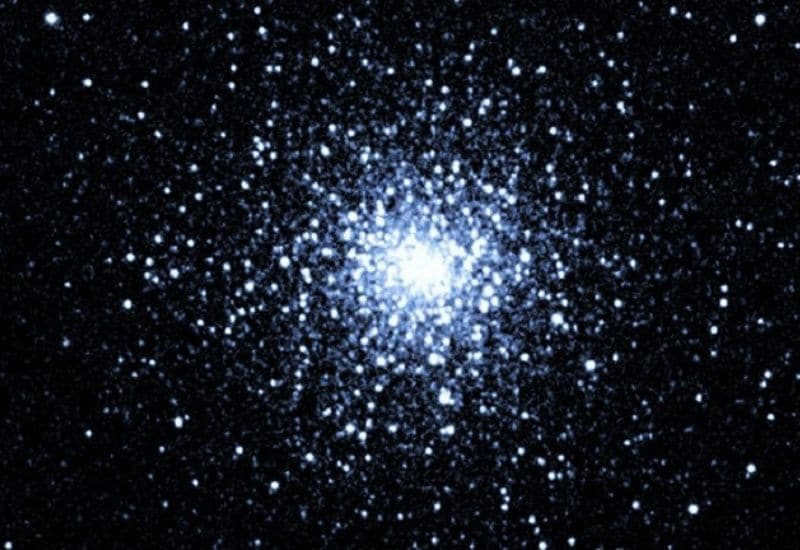
The most prominent member of M30 is a red giant star with a magnitude of 12. Like many other stars in this constellation, it has already completed its core collapse phase.
Interestingly, it was in Capricornus that scientists Henry Louis d’Arré and Johannes Galle were able to observe the discovery of Neptune, the eighth planet of the solar system. This significant event took place in 1846.
The constellation Capricorn was recorded in ancient Babylonian tablets, indicating that it was discovered as early as the 3rd millennium BC.
In ancient times, this constellation was known as the Goat, Goatfish, or simply the Goat. However, it was officially added to the celestial map by the renowned ancient astronomer Ptolemy in his catalog of astronomical objects called Almagest. It is possible that Capricorn caught people’s attention because, in the past, it marked the point of the winter solstice. This is also why the line dividing the Southern Temperate Zone in the south of our planet and the tropics in the north is known as the Tropic of Capricorn. While in modern times, the point of the winter solstice is located in the constellation Sagittarius, the tropic has retained its original name.
Greek mythology offers an explanation for the creation of the constellation associated with the story of Elian Capricorn, the son of Zeus, the most powerful god in the Hellenistic world. In his early years, Zeus was a young boy who was concealed by his mother to protect him from his violent father, Cronus. Capricorn eventually became Zeus’ loyal companion and ally when he chose to defy Cronus. As a token of gratitude for his friendship, Zeus transformed Capricorn into the modest constellation that we are discussing on this webpage.
There is a theory that suggests Capricorn may be the incarnation of the mischievous Pan, who once roamed the enchanted forests of Greek mythology, enchanting all with his flute and pursuing the most beautiful beings. Legend has it that when the powerful monster Typhon threatened the gods of Olympus, they transformed their appearances to hide from the beast’s wrath. In a desperate attempt to scare off Typhon, Pan leaped into the Nile, his lower body transforming into the tail of a fish while his upper body morphed into the head, chest, and front legs of a goat…..
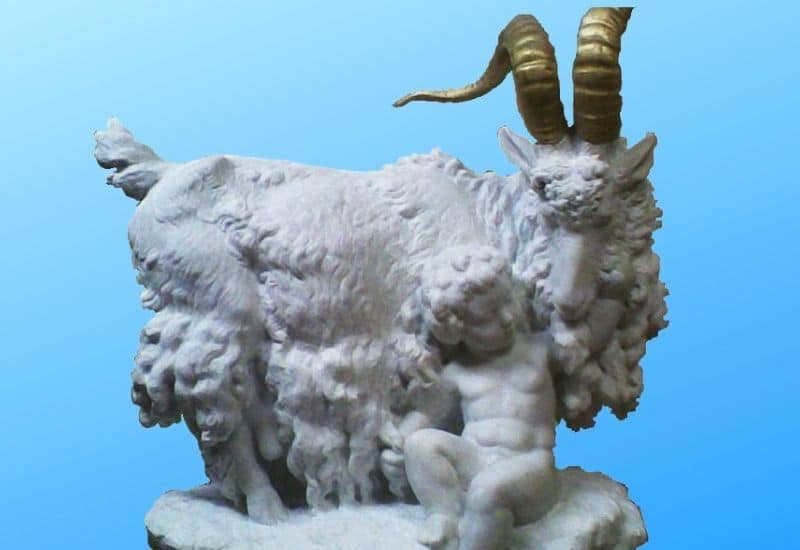
It is believed by some that the constellation of Capricorn represents the celestial manifestation of Amalthea, the goat who nursed Zeus while he was hidden from Cronus by his mother, who intended to devour him. However, there are many other versions of the constellation’s origin! This is not surprising, considering that the half-goat, half-fish beings of the constellation have been known for thousands of years.
Capricorn (Capricornus) is a zodiacal constellation in which the Sun resides from January 19 to February 15, making July and August the best time to observe it. Unfortunately, even during this period, it does not rise very high in the sky in the middle belt of Russia, making it less convenient for observation.
The presence of the constellation Capricorn in the celestial sphere
In the vast expanse of the night sky, during the months of July and August, one can observe the enigmatic constellation known as Capricorn. Positioned in the southern region, it does not ascend to great heights above the horizon. With a lack of luminous and prominent stars, Capricorn effortlessly blends into the moonlit backdrop, making it quite challenging to identify. For a thorough examination of this constellation, it is advisable to select a night devoid of the Moon’s radiant glow.

The appearance of the Capricorn constellation is easily recognizable in the night sky. Its stars create a unique pattern that resembles a cheerful grin. In case you encounter any challenges in locating it, you can begin by locating Altair, the prominent star in the Eagle constellation. Just beneath and to the left of Eagle, you will discover the captivating Capricorn constellation.
The legend of the Capricorn constellation
There is a myriad of legends and myths surrounding the origin of the Capricorn constellation, making it difficult to determine a definitive story. However, one of the most popular myths traces back to the ancient Greek supreme god, Zeus. According to this myth, Zeus was fed the milk of the goat Amalthea by his mother, Rhea, in secret from his father, Cronus. Cronus had been warned that he would be slain by his own son, so he devoured all of his newborn children.
In some versions of the myth, Amalthea is not portrayed as a goat, but rather as a nymph who possessed a goat. Whether as a goat or a nymph, Amalthea is said to have had a broken horn. In the nymph version, she also possessed a bull’s horn, which is famously known as the Horn of Plenty.
According to another account, Capricorn was raised alongside the deity Zeus and subsequently assisted him in the battle for supremacy in every conceivable manner. In return for his service, Zeus immortalized Capricorn by placing him in the sky as a constellation.
Within Babylonian records, Capricorn is referenced as the Goat-Fish, a creature with the lower body of a fish and the upper body of a human. This monstrous being would interact with humans during daylight hours, imparting various forms of knowledge, before retreating to the sea at nightfall. Some scholars interpret this as evidence of an advanced civilization known as the Atlanteans, who possessed the ability to adapt to an aquatic existence.
According to alternate myths, the Capricorn constellation represents the god Pan, the lord of fields and forests who possessed goat-like hooves and would consume shepherds. Pan was a foster brother to Zeus, and his mother was the same goat named Amalthea who also nourished Zeus.
Fascinating attractions in the constellation Capricorn
There are only a few captivating attractions in the constellation Capricorn – a pair of brilliant stars and the magnificent globular cluster M 30. It is certainly worth taking a moment to admire these celestial wonders and acquaint oneself with the constellation, especially since they are easily observable. The only challenge may arise at lower latitudes, where the constellation appears quite low above the horizon. However, the further south one ventures, the higher it ascends into the night sky.
Within this constellation, there are only a handful of luminous stars, with delta shining the brightest, unlike the typical scenario where alpha takes the lead. Alpha and beta form another duo of the most radiant stars in Capricorn.
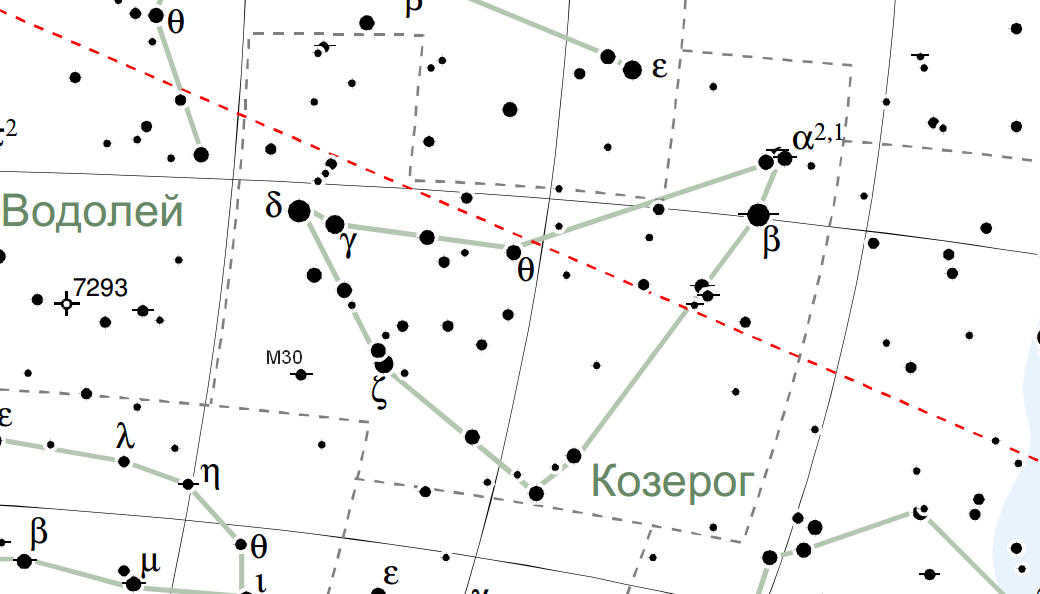
The brightest star in the constellation Capricorn is Deneb Algedi
Deneb Algedi, also known as δ (delta), got its name from the Arabic term meaning “tail of the goat.” Despite being a double star, its components are so close together that they cannot be distinguished even with a telescope. Additionally, Deneb Algedi is an eclipsing variable star belonging to the Algol class.
Deneb Algedi has a maximum brightness of +2.81 m, but it can decrease by 0.24 m. Its luminosity varies with a period of 1.022768 days.
This variable star is not very useful for visual observations, especially without much experience. The small difference in brightness leads to large errors in estimating the light, especially because the secondary minimum only varies by 0.09 m. Consequently, it would be more effective to study this variable star using the photographic method.
Algedi is the alpha star in the Capricorn constellation
Despite being called alpha, Algedi is actually the third brightest star in the constellation, with delta and beta being brighter. Its Arabic name, Aljedi, translates to “goat”. Algedi has a brightness of +4.24 m, making it relatively dim, although it is still one of the brightest stars in Capricorn.
When observed through binoculars, Algedi appears double. It is composed of two components, Alpha-1 and Alpha-2, with the latter being noticeably brighter. However, these two stars are not actually related to each other. Alpha-1 is located 690 light-years away, while Alpha-2 is situated 109 light-years away. They simply appear to be close together due to their alignment. Such stars are referred to as optical twins.
However, that is not the only thing – each of these two stars is, in fact, a binary system. Their primary components belong to a somewhat uncommon variety of yellow supergiants, and both have exhausted their hydrogen and are transitioning to helium burning. It is an exceptionally exceptional coincidence.
The Alpha 1 system might not be a binary system, but rather a multiple system, featuring two additional stars alongside the primary star. Yet, it is still uncertain whether they are all physically linked.
Dabih: The Beta Capricornus Star
Presenting itself as the second brightest star in the Capricornus constellation, Dabih showcases a brightness level of approximately +3.08m. A closer look through binoculars reveals its fascinating nature as a double star, with two separate components boasting brightness levels of +3.05m and +6.09m, respectively. The remarkable distance of about 21,000 astronomical units separates these components, with the second star completing a full revolution in its orbit every 700,000 years.
However, the intricacies of Dabih go beyond this apparent duality. Dabih is actually a multiple star, devoid of the commonly perceived two-component structure.
The initial companion is a triple star system, with the primary star being an orange giant that is 35 times larger than the Sun and 600 times more luminous. It is accompanied by a companion star located at a distance of only 5 astronomical units (a.u.), and this companion star also has its own companion that completes a revolution around it in just 8.7 days. It is possible that the primary star in this system also has an additional close companion, which would make it a four-star system.
The second companion is a binary star system, consisting of a white giant star that is 40 times brighter than the Sun. This star is unique in that its atmosphere has high concentrations of manganese and mercury. Its companion star is located 3 angular seconds away from it.
Make sure you use binoculars or telescopes to observe Beta Capricorn. You are guaranteed to spot a star or two in that area. Such multiple systems are not very common.
Capricorn’s Star Clusters
Capricorn doesn’t offer many points of interest. The only globular cluster, M30, available for astronomy enthusiasts is located in the lower left part of the constellation. However, it is inconvenient for observations as it is too close to the horizon. Nevertheless, it can be found in the southern regions of Russia.
The cluster M30 is renowned for its stunning beauty and grandeur. With a magnitude of +7.19, it can be observed with ease using small telescopes. However, locating this celestial gem can pose a challenge, as it resides in a relatively sparsely populated area of the sky, devoid of distinctive landmarks. Nevertheless, those with sufficient expertise can navigate their way to M30 without much difficulty.
